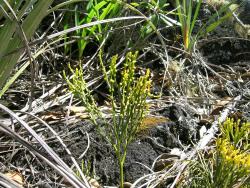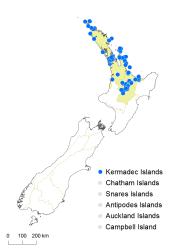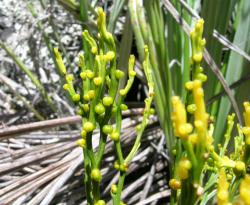- ≡ Lycopodium nudum L., Sp. Pl. 1100 (1753)
- = Psilotum triquetrum Sw., J. Bot. (Schrader) 1800(2): 109 (1801)
- = Bernhardia novae-hollandiae Müll.Berol., Bot. Zeitung (Berlin) 14: 237 (1856)
- = Psilotum heterocarpum Colenso, Trans. & Proc. New Zealand Inst. 20: 237 (1888)
- = Psilotum novae-zelandiae Gand., Bull. Soc. Bot. France 66: 306 (1919)
Terrestrial, rupestral or occasionally epiphytic ferns. Aerial stems erect, 40–725 mm long, 13–290 mm wide. Unbranched portion of stem 20–420 mm long, 0.5–3 mm in diameter, green or yellow-green; distal portion dichotomously branched 3-many times, strongly ribbed, green, stiff or sometimes flaccid in shaded habitats, glabrous. Sterile leaves 1–3 mm long, scale-like, confined to ribs, spirally arranged, pale yellow, lacking veins. Synangia 1–1.5 mm long, 1.5–3 mm wide, yellow, unprotected, projecting slightly from sides of stems.
This species is easily recognised by its twiggy, upright stems, scale-like leaves, and trilobed synangia borne adaxially on bifid sporophylls.
North Island: Northland, Auckland, Volcanic Plateau.
Kermadec Islands.
Altitudinal range: 0–450 m.
Psilotum nudum occurs on Raoul Island and in coastal areas of Northland, but is uncommon on the mainland in the Auckland region, except around Auckland City, on Rangitoto Island and in eastern Coromandel. It has been collected on offshore islands from the Poor Knights Islands to Whale Island in the eastern Bay of Plenty, and has been reported (without voucher) from Urupukapuka Island in the Bay of Islands (Young 2009). On the west coast it extends to Kāwhia Harbour, and it is common on thermally heated soils of the Rotorua/Taupō region as far south as Tokaanu. It occurs from near sea level to about 150 m in most of its range, but grows up to 400 m on Raoul Island and 450 m on the cliffs around Lake Rotomahana.
Also widespread in tropical and subtropical regions including Australia (Western Australia, Northern Territory, Queensland, NSW, Victoria) and most islands of the Pacific.
On Raoul Island, Psilotum nudum is common under dry forest in the crater area, usually on the forest floor, but also on rotten wood or epiphytic on Metrosideros. In Northland and on the Hauraki Gulf and Coromandel islands it occurs under pōhutukawa forest on rocky or sandy soil, on open coastal cliffs and banks, in rock crevices and amongst scoria. Very occasionally it occurs as an epiphyte on pōhutukawa or kōwhai. In Auckland City it is found on walls, in rocky areas, amongst scoria and in planted areas, where it has been accidentally introduced. Around Kāwhia Harbour it grows on limestone outcrops. However, it is most abundant on thermally heated ground in the Rotorua/Taupō area on cliffs, rocky ground, in crevices, around steam vents and under light kānuka and mānuka scrub.
n = 104 (Brownsey & Lovis 1987).
The gametophytes of Psilotum nudum are unusual amongst ferns in being subterranean, non-green, mycorrhizal, cylindrical and frequently branched (Holloway 1939; Bierhorst 1954). They are similar to those of Tmesipteris in this regard.






